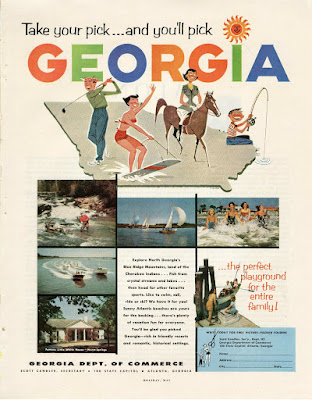On Thursday, April 21, 2016 the Richard B. Russell Library for Political Research and Studies and the UGA Department of History will host Dr. Tammy Ingram, assistant professor of history at the College of Charleston, for a lecture titled "Driving Dixie: The Politics of Early Automobile Tourism" at 4:00 p.m. in the auditorium of the Richard B. Russell Building Special Collections Libraries (Room 271).
Ingram's talk will focus on the ways that automobile tourism reshaped both the physical and political landscapes of the South, and Georgia in particular, from the 1910s through the 1930s. "I plan to examine both the effects of tourism on transportation policymaking in the state," said Ingram, and also "the ways in which public enthusiasm for new highway projects and tourist dollars inspired businessmen and politicians alike to sell a very specific vision of the state—and the South—to early automobile tourists." She will also explain how farmers, the most important constituency in the state, took advantage of expensive transportation networks that were built primarily to serve wealthy northern and midwestern tourists. "In the process they, too, helped to remake the state and the region by facilitating the rise of agribusiness and tourism," said Ingram, still two of the biggest sources of revenue in the state a century later.
Following the lecture, attendees are invited to a light reception and book signing for Ingram's recent book Dixie Highway: Roadbuilding and the Making of the Modern South, 1900-1930. A screening of the Georgia Public Broadcasting documentary Down the Dixie Highway will follow at 6:30 p.m.
This event is co-sponsored by the Richard B. Russell Library for Political Research and Studies and the Department of History at the University of Georgia.
 More about Dr. Tammy Ingram
More about Dr. Tammy IngramDr. Ingram received her PhD from Yale University in 2007 and is currently an assistant professor at the College of Charleston, where she teaches courses on the modern South, twentieth century U.S. politics, and urban history. Her first book, Dixie Highway: Road Building and the Making of the Modern South, 1900-1930, was published by the University of North Carolina Press in March of 2014. It is the first comprehensive study of the Progressive Era Good Roads Movement and the first monograph about the Dixie Highway, a largely forgotten 6000-mile network of roads that crisscrossed the South and Midwest from Lake Michigan to Miami Beach. The book has been awarded an Excellence in Research Award by the Georgia Historical Records Advisory Council, the 2015 Malcolm Bell, Jr. and Muriel Barrow Bell Award by the Georgia Historical Society, and was named a 2014 Book of Interest by the Business History Conference. In July 2016, UNC Press will release a paperback edition of the book.
Professor Ingram’s new book project, The Wickedest City in America: Sex, Race, and Organized Crime in the Jim Crow South, offers a broad view of organized crime networks in the postwar U.S. but focuses on a loosely connected group of individuals in the South nicknamed the Dixie Mafia. Ingram has also explored some of her scholarly research interests in several blogs and op-eds for outlets such as the History News Network, Like the Dew, the Huffington Post, and the Atlanta Journal-Constitution.





















